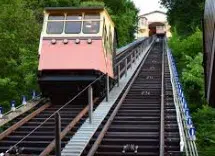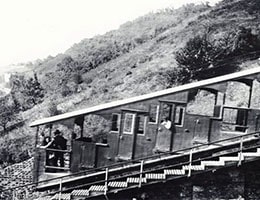 The etymology of funicular refers to the Latin word funicŭlus , which translates as "rope" . The term can be used to name a vehicle that is pulled by a cable , a rope , a chain or a similar element.
The etymology of funicular refers to the Latin word funicŭlus , which translates as "rope" . The term can be used to name a vehicle that is pulled by a cable , a rope , a chain or a similar element.
The most common use of the concept refers to the funicular railway , which is used to ascend terrain with steep slopes through the use of cables . This type of vehicle does not have its own displacement capacity: mobility is provided by a motor that drives a pulley , which moves the cable used for traction. The funiculars, in any case, have their own braking systems in case there is a problem with the cable, the pulley or the motor.
The operation of a funicular is similar to that of an elevator or elevator , although funiculars run on rails . Generally there are two cabins of which one goes up and the other goes down, taking advantage of the potential energy.
It is possible to find funiculars in many countries . The Chilean city of Valparaíso , for example, is famous for its funiculars that make it easy to climb the hills. The first of these elevators began operating in 1883 .
The Chilean capital also has funiculars: it is located in the Santiago Metropolitan Park . These were inaugurated in 1925 to facilitate the arrival to the upper part of the San Cristóbal hill .
The Montjuïc funicular, on the other hand, is public transport that allows you to go from Barcelona to Montjuïc mountain. The system , which has two stations, runs almost 800 meters and allows you to ascend 76 meters.
It is important to note that the funicular is one of the oldest creations of human beings to make journeys to places of high altitude, inaccessible or too dangerous to do on foot. Its invention took place more than a century ago, although some scholars point out that there is evidence of its existence in the 17th century.
 Let us not forget that for several centuries only a few people could reach the most imposing peaks : whether they were the wealthiest or those with the greatest physical preparation, they were a true elite who could carry out expeditions that were not within the reach of the majority. Thanks to the arrival of the funiculars, and later the cable cars, this line was dissolved to allow anyone to discover these impressive landscapes.
Let us not forget that for several centuries only a few people could reach the most imposing peaks : whether they were the wealthiest or those with the greatest physical preparation, they were a true elite who could carry out expeditions that were not within the reach of the majority. Thanks to the arrival of the funiculars, and later the cable cars, this line was dissolved to allow anyone to discover these impressive landscapes.
While today no person outside the world of mountaineering can imagine ascending to some of the highest peaks without the help of a funicular, it goes without saying that its manufacture required the work of many people in truly dangerous situations. The comfort offered by this technology, which has come a long way since its inception, confronts risk lovers and those who simply want to get to know the mountains without making any physical effort.
Something similar happens with shelters : while daredevil climbers maintain that luxury and sophistication is not necessary, but rather a focus on protection is enough, many demand a deployment of architectural technology to offer an experience similar to that of a five-star hotel. stars.
According to historians, the first known Spanish funicular is the Tibidabo ; It was built in the Serra de Collserola , Barcelona, in 1901. On the other hand, one of the most modern, Mamariga , dates back to 2010 and is located in the municipality of Santurce , in the Basque Country. Among the reasons that drove the emergence and development of the funicular as a means of transportation to and from mountain peaks are tourism and population growth in regions with marked unevenness.
